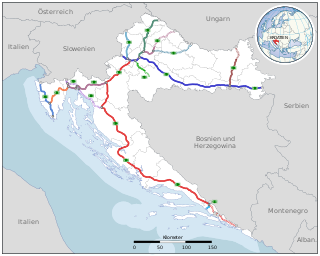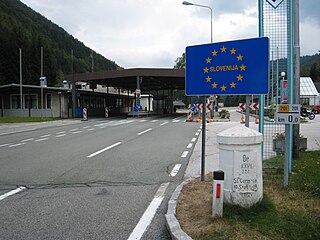
Transport in Croatia relies on several main modes, including transport by car, train, boat and plane. Road transport incorporates a comprehensive network of state, county and local routes augmented by a network of highways for long-distance travelling. Water transport can be divided into sea, based on the ports of Rijeka, Ploče, Split and Zadar, and river transport, based on Sava, Danube and, to a lesser extent, Drava. Croatia has 68 airports, nine of which are international. The country also has several airlines, of which the most notable are Croatia Airlines and Trade Air. Rail transport is fairly developed, with dual track and electrification not very common, although high-speed tilting trains are used on some routes. However, bus still tends to be more common than rail as a mode of inter-city transport.
Transport in Serbia includes transport by road, rail, water and air. Road transport incorporates a comprehensive network of major and minor roads. Rail transport is fairly developed, although dual track and electrification are not very common. Water transport revolves around river transport while air transport around country's two main international airports.

The Orient Express was a long-distance passenger train service created in 1883 by the Belgian company Compagnie Internationale des Wagons-Lits (CIWL) that operated until 2009. The train traveled the length of continental Europe and into western Asia, with terminal stations in London in the northwest and Athens or Istanbul in the southeast.

The Brotherhood and Unity Highway, officially classed as the M-1 highway, was a highway that stretched over 1,182 km (734 mi) across Yugoslavia, from the Austrian border at Jesenice in the northwest via Ljubljana, Zagreb, Belgrade and Skopje to Gevgelija on the Greek border in the southeast. It was the main modern highway in the country, connecting four constituent republics and the country as a whole with neighboring highways.

Gastarbeiter are foreign or migrant workers, particularly those who had moved to West Germany between 1955 and 1973, seeking work as part of a formal guest worker program (Gastarbeiterprogramm). Other countries had similar programs: in the Netherlands and Belgium it was called the gastarbeider program; in Sweden, Denmark, Norway and Finland it was called arbetskraftsinvandring (workforce-immigration); and in East Germany such workers were called Vertragsarbeiter. The term was used during the Nazi era as was Fremdarbeiter. However, the latter term had negative connotations, and was no longer used after World War II.

Bundesautobahn 7 is the longest German Autobahn and the longest national motorway in Europe at 963 km. It bisects the country almost evenly between east and west. In the north, it starts at the border with Denmark as an extension of the Danish part of E45. In the south, the autobahn ends at the Austrian border. This final gap was closed in September 2009.

European route E 59 is a north-south Class-A intermediate European route. It begins in Prague, Czech Republic, passes through Vienna, Austria and Maribor, Slovenia, ending near Zagreb, Croatia. The total length of the route is 644 km (400 mi). The E59 largely consists of motorways but some sections are developed either as expressways or two-lane roads with at-grade intersections. The motorway sections are generally tolled through varying systems and rates. Individual segments of the E59 route are shared with several other European routes. Originally, the route extended through Bihać, Bosnia and Herzegovina to Split, Croatia.

The Austrian autobahns are controlled-access highways in Austria. They are officially called Bundesstraßen A (Bundesautobahnen) under the authority of the Federal Government according to the Austrian Federal Road Act (Bundesstraßengesetz), not to be confused with the former Bundesstraßen highways maintained by the Austrian states since 2002.
Aeroput was an airline and flag carrier of Yugoslavia from 1927 until 1948.

The Wurzen Pass is a mountain pass in a col of the Karawanks mountain range in the Southern Limestone Alps, on the border between Radendorf in the Austrian state of Carinthia and Kranjska Gora in Slovenia. It is named after the nearby village of Podkoren (Wurzen).

Egnatia Odos or Egnatia Motorway is the Greek part of European route . It is a motorway in Greece that extends from the western port of Igoumenitsa to the eastern Greek–Turkish border at Kipoi. It runs a total of 670 km (420 mi). The megaproject began in 1994 and was completed in 2009 at a cost of €5.93 billion ; it was managed by the state-owned company Egnatia Odos, S.A.

The Corridor X is one of the pan-European corridors. It runs between Salzburg in Austria and Thessaloniki in Greece. The corridor passes through Austria, Slovenia, Croatia, Serbia, North Macedonia, and Greece. It has four branches: Xa, Xb, Xc, and Xd.

Croatia–Germany relations are foreign relations between Croatia and Germany. The countries established diplomatic relations on 15 January 1992. Croatia has an embassy in Berlin and five consulates general in Düsseldorf, Frankfurt, Hamburg, Munich and Stuttgart. Germany has an embassy in Zagreb and an honorary consulate in Split.

The Zagreb train disaster occurred on 30 August 1974 when an express train traveling from Belgrade, Yugoslavia, to Dortmund, West Germany, derailed before entering Zagreb Main Station, killing 153 people. It was the worst rail accident in Yugoslavia's history to that date and remains one of the worst in Europe's history.

The Děčín–Dresden railway, also called the Elbe Valley Railway is an electrified main line in Saxony and the Czech Republic. Formerly called the Saxon-Bohemian State Railway, the line is part of the Dresden to Prague route and is one of Europe's most important trunk routes (Magistralen). It runs along the Elbe Valley from Děčín via Bad Schandau and Pirna to Dresden. The first section of the line was opened in 1848 and is one of the oldest lines in Germany.

The Munich–Rosenheim railway is a 65 kilometre-long double-track main line of the German railways. It connects Munich Hauptbahnhof with Rosenheim station, where it connects with the Rosenheim–Salzburg railway, which connects with the line to Vienna at Salzburg, and the line to Kufstein, which continues to Innsbruck and the Brenner line to Italy. The line is part of the "Main line for Europe", connecting Paris with Bratislava and Budapest and the almost identical line 17 of Trans-European Transport Networks (TEN-T). It is part of the line 1 of TEN-T. It is electrified at 15 kV, 16.7 Hz. It was opened between Munich and Rosenheim in 1871.

The Chemins de fer Orientaux was an Ottoman railway company operating in Rumelia and later European Turkey, from 1870 to 1937. The CO was one of the five pioneer railways in the Ottoman Empire and built the main trunk line in the Balkans. Between 1889 and 1937, the railway hosted the world-famous Orient Express.

The Tauern Railway is an Austrian railway line between Schwarzach-Sankt Veit in the state of Salzburg and Spittal an der Drau in Carinthia. It is part of one of the most important north-south trunk routes (Magistrale) in Europe and also carries tourist traffic for the Gastein Valley. The standard gauge railway line is 79 km (49 mi) long and climbs the High Tauern range of the Central Eastern Alps with a maximum incline of 2.5%, crossing the Alpine crest through the 8,371 m (27,464 ft) long Tauern Tunnel. It is one of the highest standard gauge railways in Europe and the third highest in Austria.
The Rosenheim–Salzburg railway is a continuous double track and electrified main line railway almost entirely within the German state of Bavaria. It is an international transport corridor, linking Rosenheim to Salzburg in Austria.

The Corridor IV is one of the Pan-European transport corridors. It runs between Dresden/Nuremberg in Germany and Thessaloniki (Greece) / Constanța (Romania) / Istanbul (Turkey). The corridor follows the route: Dresden / Nuremberg – Prague – Vienna – Bratislava – Győr – Budapest – Arad – Bucharest – Constanța / Craiova – Sofia – Pernik - Thessaloniki or Plovdiv – Istanbul.

















